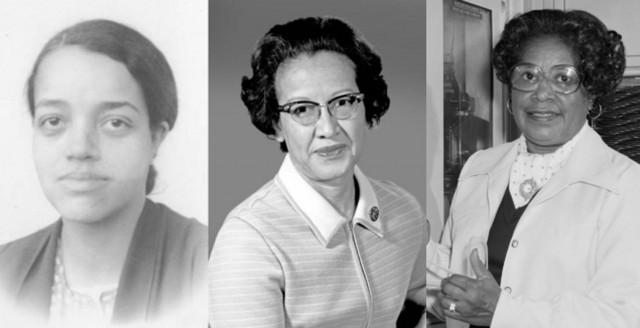Meet the women who helped put the US into space
Damien Chazelle's "La La Land" seems inescapable at this point, but there's one movie that has outshone it in the box office and is now considered a front-runner at the Academy Awards.
"Hidden Figures" has yet to hit Philippine theaters, but in the US, this movie about three black women who strove—hard—to achieve academic excellence already made $119.5 million.
Amid the #OscarsSoWhite controversy, the routine whitewashing of roles ("Exodus: Gods and King", "Pan", "Gods of Egypt", and "Ghost in the Shell" to name a few), and the uphill fight for representation, the success of "Hidden Figures" must be celebrated.
Mekita Rivas for GOOD Magazine sums it up for Hollywood executives: "Make diverse movies with people who look like us and who have our stories to tell, and we’ll show up at the box office."
Aside from the issue of racial discrimination, "Hidden Figures" also clearly illustrates the never-ending stream of excrement women are expected to brush off and rise above in the work place.
Watching Katherine Johnson, Dorothy Vaughan, and Mary Jackson deal with "mansplaining" even though all three are accomplished in the fields of analytical geometry, engineering and rocket science might cause one to pop a vein—but we can learn a thing or two from their grace, determination, and focus.
Few people know their names and maybe that should change. Meet the three pioneering black women of the National Aeronautics and Space Administration.
 (Left to right): Dorothy Vaughan, Katherine Johnson, and Mary Jackson
(Left to right): Dorothy Vaughan, Katherine Johnson, and Mary Jackson
DOROTHY VAUGHAN (Octavia Spencer)
Born in Kansas City, Missouri, in 1910, Dorothy Vaughan was a gifted child who excelled academically and musically. Her family relocated to West Virginia when she was eight. Aged 15, Vaughan won a full scholarship to Wilberforce University in Ohio. Married to Howard Vaughan, the mother of six was a schoolteacher before joining NASA’s Langley Research Center as a computer in the 40s. She was promoted to a management position and became NASA’s first black supervisor.
A fierce champion for her staff, Vaughan devoted herself to fighting for promotions and pay raises for both black and white women computers. With the introduction of the first electronic computers to NASA, Vaughan had the foresight to realize that the role of the human computer would vanish. Reinventing herself, she learned how to program the IBM, becoming proficient in Fortran (computer programing language). Vaughan also encouraged the women in her department to become computer programmers, in order to save their jobs. She joined the new Analysis and Computation Division (ACD), a racially and gender-integrated group on the frontier of electronic computing. Dorothy Vaughan died in 2008.
KATHERINE JOHNSON (Taraji P. Henson)
One of the brightest minds of her generation, mathematician, physicist and space scientist, Katherine Johnson was born in West Virginia in 1918. Displaying an early aptitude for math, she was brilliant with figures. Encouraged by her parents and teachers, Johnson attended West Virginia State College and graduated with highest honors.
She became the first African American woman to attend graduate school at West Virginia University, when the state first integrated its graduate schools in 1930. Originally a teacher, Johnson was hired as a computer at NASA’s Langley Research Center in 1953. She was assigned to the Flight Research Division and became indispensable, doing calculations for orbital trajectories on the early Mercury flights. Johnson did trajectory analysis for Alan Shepard, the first American in Space.
Her math was instrumental to the success of the historic Friendship 7 Mission, in which astronaut John Glenn became the first American to orbit the earth. The early electronic IBM computer was essential to Glenn’s flight, but not reliable, so Glenn insisted that “the girl” (he meant Johnson) manually check the numbers before his flight. The successful flight, of course, marked a turning point in the Space Race between the United States and the former Soviet Union. The stellar mathematician also worked on the calculations for the 1969 Apollo 11 flight to the moon, the Space Shuttle and the Earth Resources Satellite.
Johnson has three daughters from her first marriage to James Goble, who died in 1956. Since 1959, she has been married to Colonel James Johnson. In 2015, Katherine Johnson was awarded the Presidential Medal of Freedom from President Obama.
MARY JACKSON (Janelle Monáe)
Born in Hampton Virginia in 1921, Mary Jackson graduated in math and physical science from Hampton Institute. Married to Levi Jackson Sr., the mother of two initially worked as teacher. A gifted mathematician, Jackson started her NASA career as a computer. Recognized for her excellent engineering skills, Jackson was encouraged by NASA engineer Kazimierz Czarnecki to enter a training program that would enable her to be promoted from mathematician to engineer.
Tenacious and courageous, she petitioned to be allowed into a segregated white high school, in order to take the college courses required for her to work officially as a NASA engineer. Winning her fight and completing her qualifications, Jackson went on to become NASA’s first black female aerospace engineer and is thought to be the first black female engineer in the United States. Deeply concerned about equality for women, later in her career, Jackson took a demotion to become a human resources manager. Among the honors she received was an Apollo Group Achievement Award. For three decades, Jackson was an enthusiastic Girl Scouts leader. She died in 2005. — AT/TJD, GMA News
"Hidden Figures" opens in Philippine theaters on February 22.




